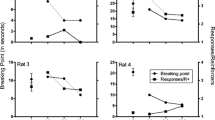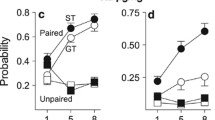Abstract
In general, chlordiazepoxide (CDP) and amphetamine reduce high rates of responding and increase low rates (rate-dependent effect). However, unlike CDP, amphetamine does not typically increase low rates resulting from suppression of responding by noxious stimuli. In the present experiment, key pecking by pigeons was reinforced under a random ratio schedule of food presentation. This responding was then suppressed by stimuli correlated with electric shocks of varying intensity (2 or 4 mA) or reduced by the omission of the food (extinction). Treatment with CDP (0.3–10.0 mg/kg) and morphine (0.3–10.0 mg/kg) increased the rate of suppressed responding: lower rates being increased to a proportionately greater extent than high rates.d-Amphetamine (0.1–1.0 mg/kg) further reduced the rate of suppressed responding: the lower rates being reduced proportionately more than the higher rates. Thus the effects of all three drugs depended upon the control rates of responding, but the effects of amphetamine were the inverse of those of CDP and morphine. The effects of amphetamine on low, suppressed or punished response rates are therefore not an exception to the generality of rate-dependency, but a different aspect of the same principle — “inverse rate-dependency”.
Similar content being viewed by others
References
Azrin NH (1959) A technique for delivering shock to pigeons. J Exp Anal Behav 2:161–163
Cook L, Catania AC (1964) Effects of drugs on avoidance and escape behavior. Fed Proc 23:818–835
Cook L, Davidson AB (1973) Effects of behaviorally active drugs in a conflict-punishment procedure in rats. In: Garattini S, Mussini E, Randall LO (eds) The benzodiazepines. Raven Press, New York, pp 327–245
Dews PB, Wenger GR (1977) Rate-dependency of the behavioral effects of amphetamine. In: Thompson T, Dews PB (eds) Advances in behavioral pharmacology, vol 1. Academic Press, New York, pp 167–222
Evenden JL, Ryan CN (1989) Behavioral responses to psychomotor stimulant drugs: localization in the central nervous system. In: Balfour DJK (ed) Psychotropic drugs of abuse. Pergamon Press, New York, pp 1–22
Ferster C, Skinner BF (1957) Schedules of reinforcement. Appelton-Century-Crofts, New York
Foree DD, Moretz FH, McMillan DE (1973) Drugs and punished responding II.d-Amphetamine-induced increases in punished responding. J Exp Anal Behav 20:291–300
Geller I, Seifter J (1960) The effects of meprobamate, barbiturates,d-amphetamine and promazine on experimentally induced conflict in the rat. Psychopharmacologia 1:482–292
Hearst E (1965) Stress induced breakdown of an appetitive discrimination. J Exp Anal Behav 8:135–146
Hill RT (1970) Facilitation of conditioned reinforcement as a mechanism of psychomotor stimulation. In: Costa E, Garattini S (eds) Amphetamines and related compounds. Raven Press, New York, pp 781–795
Jeffery DR, Barrett JE (1979) Effects of chlordiazepoxide on comparable rates of punished and unpunished responding. Psychopharmacology 64:9–11
Ksir C (1981) Rate-convergent effects of drug. In: Thompson T, Dews PB, McKim WA (eds) Advances in behavioural pharmacology vol 3. Academic Press, New York, pp 39–59
McKim WA (1981) Rate-dependency: a nonspecific behavioral effect of drugs. In: Thompson T, Dews PB, McKim WA (eds) Advances in behavioral pharmacology, vol 3. Academic Press, New York, pp 61–73
McMillan DE (1973a) Drugs and punished responding I. Rate dependent effects under multiple schedules. J Exp Anal Behav 19:133–145
McMillan DE (1973b) Drugs and punished responding II. Punishment intensity as a determinant of drug effect. Psychopharmacologia 30:61–74
Robbins TW (1976) Relationship between reward-enhancing and stereotypical effects of psychomotor stimulant drugs. Nature 264:57–59
Robbins TW (1982) Behavioural determinants of drug action. In: Cooper SJ (ed) Theory in psychopharmacology, vol 1. Academic Press, New York, pp 1–63
Sepinwall J, Grodsky FS, Cook L (1978) Conflict behavior in the squirrel monkey: effects of chlordiazepoxide, diazepam and N-desmethyldiazepam. J Pharmacol Exp Ther 204:88–102
Spealman R (1979) Comparison of drug effects on responding punished by pressurized air or electric shock delivery in squirrel monkeys: pentobarbital, chlordiazepoxide,d-amphetamine and cocaine. J Pharmacol Exp Ther 209:309–315
Thiébot MH, Soubrié P, Sanger D (1988) Anxiogenic properties of beta-CCE and FG 7142: a review of promises and pitfalls. Psychopharmacology 94:452–463
Valentine JO, Barrett JE (1981) Effects of chlordiazepoxide andd-amphetamine on responding suppressed by conditioned punishment. J Exp Anal Behav 35:209–216
Witkin JM, Barrett JE (1976) Effects of pentobarbital on punished behavior at different shock intensities. Pharmacol Biochem Behav 5:535–538
Wuttke W, Kelleher RT (1970) Effects of some benzodiazepines on punished and unpunished behavior in the pigeon. J Pharmacol Exp Ther 172:397–405
Author information
Authors and Affiliations
Rights and permissions
About this article
Cite this article
Evenden, J.L. Effects of chlordiazepoxide, morphine and amphetamine on responding suppressed by different levels of electric shock in the pigeon are rate dependent. Psychopharmacology 105, 253–258 (1991). https://doi.org/10.1007/BF02244318
Received:
Revised:
Issue Date:
DOI: https://doi.org/10.1007/BF02244318




